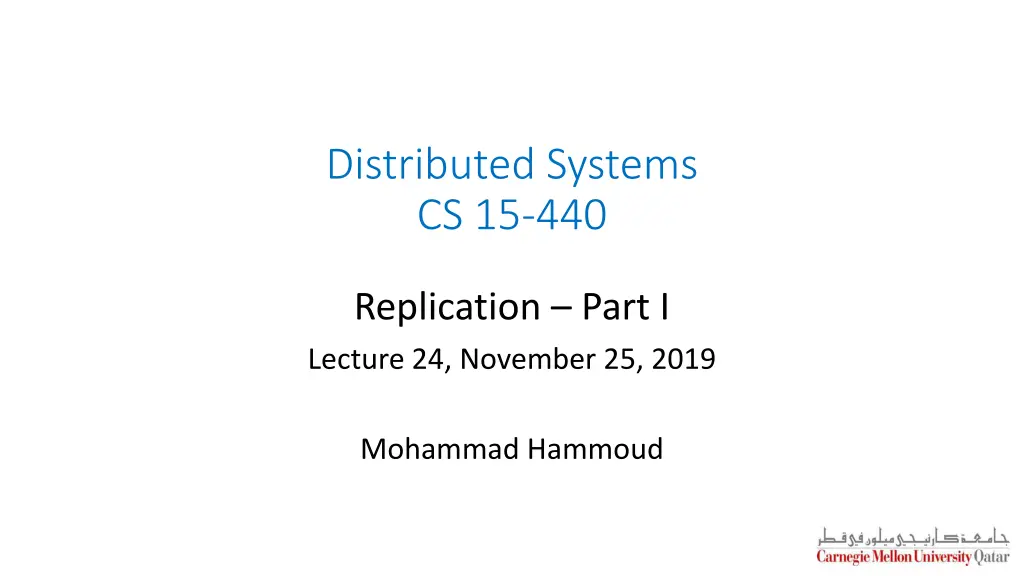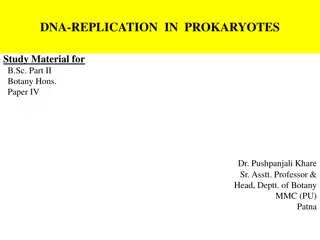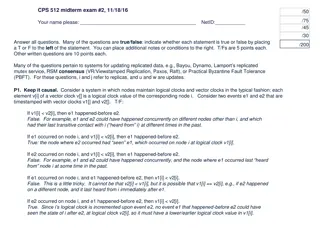
Enhancing System Performance through Data Replication
Learn how data replication plays a crucial role in improving performance, increasing availability, enhancing scalability, and securing against malicious attacks in distributed systems. Explore examples of replication for performance improvement, high availability, and scalability. Understand the necessity of replication in ensuring efficient data access, fault tolerance, and system scalability.
Download Presentation

Please find below an Image/Link to download the presentation.
The content on the website is provided AS IS for your information and personal use only. It may not be sold, licensed, or shared on other websites without obtaining consent from the author. If you encounter any issues during the download, it is possible that the publisher has removed the file from their server.
You are allowed to download the files provided on this website for personal or commercial use, subject to the condition that they are used lawfully. All files are the property of their respective owners.
The content on the website is provided AS IS for your information and personal use only. It may not be sold, licensed, or shared on other websites without obtaining consent from the author.
E N D
Presentation Transcript
Distributed Systems CS 15-440 Replication Part I Lecture 24, November 25, 2019 Mohammad Hammoud
Today Last Session: Caching (or client-side replication) Part III Today s Session: Replication (or more precisely, server-side replication) Data-Centric Consistency Models Announcements: Project 4 is due on Dec 2 by midnight PS5 is due on December 5 by midnight
Overview Today s lecture Motivation Consistency Models Data-Centric Consistency Models Client-Centric Consistency Models Consistency Protocols Next lecture
Overview Motivation Consistency Models Data-Centric Consistency Models Client-Centric Consistency Models Consistency Protocols
Why Replication? Replication is necessary for: 1. Improving performance A client can access nearby replicated copies and save latency 2. Increasing the availability of services Replication can mask failures such as server crashes and network disconnection 3. Enhancing the scalability of systems Requests to data can be distributed across many servers, which contain replicated copies of the data 4. Securing against malicious attacks Even if some replicas are malicious, security of data can be guaranteed by relying on replicated copies at non-compromised servers
1. Replication for Improving Performance Example: Replication at secondary servers in Content Delivery Network (CDNs) Main Server Secondary Servers
2. Replication for High-Availability Example: Google File-System replicates data blocks at computers across different racks, clusters, and data-centers If one computer or a rack or a cluster crashes, blocks can still be accessed from other sources
3. Replication for Enhancing Scalability Distributing data across replicated servers helps in saving the main server from becoming a performance bottleneck Example: Content Delivery Networks can decrease load at main (primary) servers Main Server Replicated Servers
4. Replication for Securing Against Malicious Attacks If a minority of servers in a system are malicious, the non-malicious servers can outvote the malicious ones This technique can also be used to provide fault-tolerance against non- malicious but faulty servers Example: In a peer-to-peer system, peers can coordinate to prevent delivering faulty data to the requester 1 2 5 Number of servers with correct data outvote the faulty servers 4 6 0 3 7 = Servers that do not have the requested data = Servers with correct data = Servers with faulty data n n n
Why Consistency? But (server-side) replication comes with a cost, which is the necessity for maintaining consistency (or more precisely consistent ordering of updates) Example: A Bank Database Event 2 = Add interest of 5% Event 1 = Add $1000 2 1 4 3 Bal=1000 Bal=2000 Bal=2100 Bal=1000 Bal=1050 Bal=2050 Replicated Database
Overview Motivation Consistency Models Data-Centric Consistency Models Client-Centric Consistency Models Consistency Protocols
Maintaining Consistency of Replicated Data DATA-STORE Replica 1 Replica 2 Replica 3 Replica n x=0 x=2 x=5 x=0 x=2 x=5 x=0 x=2 x=5 x=0 x=2 x=5 R(x)0 W(x)2 R(x)? R(x)5 Process 1 Process 2 R(x)? R(x)2 R(x)0 Process 3 W(x)5 Strict Consistency Data is always fresh After a write operation, the update is propagated to all the replicas A read operation will result in reading the most recent write If read-to-write ratio is low, this leads to large overheads =Read variable x; Result is b = Write variable x; Result is b =Process P1 =Timeline at P1 P1 R(x)b W(x)b
Maintaining Consistency of Replicated Data (Contd) DATA-STORE Replica 1 Replica 2 Replica 3 Replica n x=0 x=2 x=0 x=0 x=2 x=0 x=2 x=5 x=0 x=2 x=3 R(x)0 W(x)2 R(x)? R(x)5 Process 1 Process 2 R(x)? R(x)3 R(x)5 Process 3 W(x)5 Loose Consistency Data might be stale A read operation may result in reading a value that was written long back Replicas are generally out-of-sync The replicas may sync at coarse grained time, thus reducing the overhead =Read variable x; Result is b = Write variable x; Result is b =Process P1 =Timeline at P1 P1 R(x)b W(x)b
Trade-offs in Maintaining Consistency Maintaining consistency should balance between the strictness of consistency versus efficiency (or performance) Good-enough consistency depends on your application Loose Consistency Strict Consistency Easier to implement, and is efficient Generally hard to implement, and is inefficient
Consistency Model A consistency model is a contract between: The process that wants to use the data and the data-store A consistency model states the level (or degree) of consistency provided by the data-store to the processes while reading and writing data
Types of Consistency Models Consistency models can be divided into two types: Data-Centric Consistency Models These models define how updates are propagated across the replicas to keep them consistent Client-Centric Consistency Models These models assume that clients connect to different replicas at different times They ensure that whenever a client connects to a replica, the replica is brought up to date with the replica that the client accessed previously
Overview Motivation Consistency Models Data-Centric Consistency Models Client-Centric Consistency Models Consistency Protocols
Consistent Ordering of Operations We need to express the semantics of parallel accesses when shared data are replicated Before updates at replicas are committed, all replicas shall reach an agreementon a global ordering of the updates That is, replicas in shared data-stores should agree on a consistent ordering of updates What consistent ordering of updates can replicas agree on?
Types of Ordering Below are three major types of orderings: 1. Total Ordering 2. Sequential Ordering Sequential Consistency Model 3. Causal Ordering Causal Consistency Model
Types of Ordering Below are three major types of orderings: 1. Total Ordering 2. Sequential Ordering Sequential Consistency Model 3. Causal Ordering Causal Consistency Model
Total Ordering What is total ordering? If process Pisends a message miand Pj sends mj, and if one correct process delivers mibefore mjthen every other correct process delivers mibefore mj P1 P2 P3 m(1,1) m(3,1) Ex1: Total Order Messages can denote replica updates In the example Ex1, if P1 issues the operation m(1,1): x=x+1; and If P3 issues m(3,1): print(x); and P1 or P2 or P3 delivers m(3,1) before m(1,1) Then, at all replicas P1,P2,P3 the following order of operations are executed print(x); x=x+1; P1 P2 P3 m(1,1) m(3,1) Ex2: Not in Total Order
Types of Ordering Below are three major types of orderings: 1. Total Ordering 2. Sequential Ordering Sequential Consistency Model 3. Causal Ordering Causal Consistency Model
Sequential Ordering What is sequential ordering? If a process Pi sends a sequence of messages m(i,1),...., m(i,ni), and Process Pj sends a sequence of messages m(j,1),...., m(j,nj), Then: At any process, the set of messages received are in some sequential order Messages from each individual process should appear in the same order sent by that process At every process, mi,1should be delivered before mi,2, which should be delivered before mi,3and so on... At every process, mj,1should be delivered before mj,2, which should be delivered before mj,3and so on... P1 P2 P3 m(1,1) m(3,1) m(3,2) m(1,2) m(3,3) Valid Sequential Orders P1 P2 P3 m(1,1) m(3,1) m(3,2) m(1,2) m(3,3) Invalid Sequential Orders, but Valid Total Order
Sequential Consistency (Contd) Consider three processes P1, P2 and P3 executing multiple instructions on three shared variables x, y and z Assume that x, y and z are set to zero at start P1 P2 P3 x = 1 print (y,z) y = 1 print (x,z) z = 1 print (x,y) There are many valid sequences in which operations can be executed, respecting sequential consistency (or program order) How can a program identify the wrong sequence among the following sequences: x = 1 print (y,z) y = 1 print (x,z) z = 1 print (x,y) x = 1 y = 1 print (x,z) print (y,z) z = 1 print (x,y) print (y,z) y = 1 print (x,y) x = 1 print (x,z) z = 1 y = 1 z = 1 print (x,y) print (x,z) x = 1 print (y,z) 101011 010111 Output 000110 001011 Signature 001011 101011 001001 110101
Implications of Adopting A Sequential Consistency Model for Applications There might be several different sequentially consistent combinations of ordering Number of combinations for a total of n instructions = ?(?!) The contract between the process and the distributed data-store is that the process must accept all of the sequential orderings as valid results A process that works for some of the sequential orderings and not for others is INCORRECT
Types of Ordering Below are three major types of orderings: 1. Total Ordering 2. Sequential Ordering Sequential Consistency Model 3. Causal Ordering Causal Consistency Model
Causal vs. Concurrent events Consider an interaction between processes P1 and P2 operating on replicated data x and y W(x)a W(x)a P1 P1 R(x)a W(y)b W(y)b R(x)a P2 P2 Events are not causally related Events are concurrent Computation of y at P2 does not depend on the value of x written by P1 Events are causally related Events are not concurrent Computation of y at P2may have depended on the value of x written by P1 =Read variable x; Result is b = Write variable x; Result is b =Process P1 =Timeline at P1 P1 R(x)b W(x)b
Causal Ordering What is causal ordering? If process Pisends a message miand Pj sends mj, and if mi Lamport s happened-before relation) then any correct process that delivers mj will deliver mibefore mj P1 P2 P3 m(1,1) m(3,1) m(1,2) mj(operator is Ex1: Valid Causal Orders In Ex1: m(1,1)and m(3,1) are in Causal Order m(1,1)and m(1,2) are in Causal Order P1 P2 P3 m(1,1) m(3,1) m(1,2) In Ex2: m(1,1)and m(3,1) are NOT in Causal Order Ex2: Invalid Causal Order
Causal Consistency Model A data-store is causally consistent if: Writes that are potentially causally related are seen by all the processes in the same order But concurrent writes may be seen in a different order on different machines
Implications of adopting a Causally Consistent Data-store for Applications Processes have to keep track of which processes have seen which writes This requires maintaining a dependency graph between write and read operations Vector clocks provide a way to maintain causally consistent data-stores
Next Class Consistency Models Client-Centric Consistency Models Consistency Protocols We will study various implementations of consistency models






















